Effects of Sunshine Hours and Daily Maximum Temperature Declines and Cultivar Replacements on Maize Growth and Yields
Abstract
1. Introduction
2. Materials and Methods
2.1. Data
2.2. Model and Input Data
2.3. Model Calibration and Validation
2.4. Methodology
2.4.1. The Mann–Kendall Trend Test
2.4.2. Model Settings
3. Results
3.1. Long-Term Trend and Seasonal Change in SSH
3.2. Trends of Weather Variables over the Maize Growing Period
3.3. Analysis of Trends in the Maize Growth Period
3.4. Results of Model Calibration and Validation
3.5. The Cultivars and Cultivar Parameter Change
3.6. Maize Yield Affected by Climate and Cultivar
3.7. Causes of SSH Trends
3.8. Effects of Precipitation on the Yield
4. Conclusions
Author Contributions
Funding
Conflicts of Interest
References
- Fischer, G.; Shah, M.; Tubiello, F.V.H. Socio-economic and climate change impacts on agriculture: An integrated assessment, 1990–2080. Philos. Trans. R. Soc. Lond. 2005, 360, 2067–2083. [Google Scholar] [CrossRef]
- He, L.; Asseng, S.; Zhao, G.; Wu, D.; Yang, X.; Zhuang, W.; Jin, N.; Yu, Q. Impacts of recent climate warming, cultivar changes, and crop management on winter wheat phenology across the Loess Plateau of China. Agric. For. Meteorol. 2015, 200, 135–143. [Google Scholar] [CrossRef]
- Jesse, T.; Andrew, B.; Lawton Lanier, N. Effect of warming temperatures on US wheat yields. Proc. Natl. Acad. Sci. USA 2015, 112, 6931–6936. [Google Scholar]
- Kassie, B.T.; Asseng, S.; Rotter, R.P.; Hengsdijk, H.; Ruane, A.C.; Van Ittersum, M.K. Exploring climate change impacts and adaptation options for maize production in the Central Rift Valley of Ethiopia using different climate change scenarios and crop models. Clim. Chang. 2015, 129, 145–158. [Google Scholar] [CrossRef]
- Parry, M.L.; Rosenzweig, C.; Iglesias, A.; Livermore, M.; Fischer, G. Effects of climate change on global food production under SRES emissions and socio-economic scenarios. Glob. Environ. Chang. 2004, 14, 53–67. [Google Scholar] [CrossRef]
- Rötter, R.; Geijn, S.C.V.D. Climate Change Effects on Plant Growth, Crop Yield and Livestock. Clim. Chang. 1999, 43, 651–681. [Google Scholar] [CrossRef]
- Rosenzweig, C.; Hillel, D. Climate Change and the Global Harvest; Oxford University Press: New York, NY, USA, 1998. [Google Scholar]
- Sun, W.; Huang, Y. Global warming over the period 1961–2008 did not increase high-temperature stress but did reduce low-temperature stress in irrigated rice across China. Agric. For. Meteorol. 2011, 151, 1193–1201. [Google Scholar] [CrossRef]
- Luo, Q. Temperature thresholds and crop production: A review. Clim. Chang. 2011, 109, 583–598. [Google Scholar] [CrossRef]
- Zhang, T.; Huang, Y.; Yang, X. Climate warming over the past three decades has shortened rice growth duration in China and cultivar shifts have further accelerated the process for late rice. Glob. Chang. Biol. 2013, 19, 563–570. [Google Scholar] [CrossRef]
- Liu, B.; Ming, X.; Henderson, M.; Ye, Q.; Li, Y. Taking China’s Temperature: Daily Range, Warming Trends, and Regional Variations, 1955 2000. J. Clim. 2004, 17, 4453–4462. [Google Scholar] [CrossRef]
- Rusticucci, M.; Barrucand, M. Observed Trends and Changes in Temperature Extremes over Argentina. J. Clim. 2004, 17, 4099–4107. [Google Scholar] [CrossRef]
- Vose, R.S.; Easterling, D.R.; Gleason, B. Maximum and minimum temperature trends for the globe: An update through 2004. Geophys. Res. Lett. 2005, 32, 23. [Google Scholar] [CrossRef]
- Ye, J.; Li, F.; Sun, G.; Guo, A. Solar dimming and its impact on estimating solar radiation from diurnal temperature range in China, 1961–2007. Theor. Appl. Climatol. 2010, 101, 137–142. [Google Scholar] [CrossRef]
- Penner, J.E. Climate change: The cloud conundrum. Nature 2004, 432, 962. [Google Scholar] [CrossRef][Green Version]
- Pounds, J.A.; Bustamante, M.R.; Coloma, L.A.; Consuegra, J.A.; Fogden, M.P.; Foster, P.N.; La Marca, E.; Masters, K.L.; Merino-Viteri, A.; Puschendorf, R. Widespread amphibian extinctions from epidemic disease driven by global warming. Nature 2006, 439, 161. [Google Scholar] [CrossRef]
- Norris, J.R.; Wild, M. Trends in aerosol radiative effects over Europe inferred from observed cloud cover, solar “dimming,” and solar “brightening”. J. Geophys. Res. Atmos. 2007, 112, D8. [Google Scholar] [CrossRef]
- Power, H.C. Trends in solar radiation over Germany and an assessment of the role of aerosols and sunshine duration. Theor. Appl. Climatol. 2003, 76, 47–63. [Google Scholar] [CrossRef]
- Stanhill, G.; Cohen, S. Global dimming: A review of the evidence for a widespread and significant reduction in global radiation with discussion of its probable causes and possible agricultural consequences. Agric. For. Meteorol. 2001, 107, 255–278. [Google Scholar] [CrossRef]
- Alpert, P.; Kishcha, P.; Kaufman, Y.J.; Schwarzbard, R. Global dimming or local dimming?: Effect of urbanization on sunlight availability. Geophys. Res. Lett. 2005, 321, 317–330. [Google Scholar] [CrossRef]
- Kaiser, D.P.; Qian, Y. Decreasing trends in sunshine duration over China for 1954–1998: Indication of increased haze pollution? Geophys. Res. Lett. 2002, 29, 38-1–38-4. [Google Scholar] [CrossRef]
- Li, Z.; Zhang, W.; He, Y.; Wang, X.; Catto, N.; An, W.; Du, J.; Chen, A.; Liu, L.; Hu, M. Decreasing trend of sunshine hours and related driving forces in Southwestern China. J. Lanzhou Univ. 2012, 109, 305–321. [Google Scholar]
- Liang, F.; Xia, X.A. Long-term trends in solar radiation and the associated climatic factors over China for 1961–2000. Ann. Geophys. 2005, 23, 2425–2432. [Google Scholar] [CrossRef]
- Qian, Y.; Kaiser, D.P.; Leung, L.R.; Xu, M. More frequent cloud-free sky and less surface solar radiation in China from 1955 to 2000. Geophys. Res. Lett. 2015, 33, 311–330. [Google Scholar] [CrossRef]
- Van den Besselaar, E.; Sanchez-Lorenzo, A.; Wild, M.; Klein Tank, A.; de Laat, A. Relationship between sunshine duration and temperature trends across Europe since the second half of the twentieth century. J. Geophys. Res. Atmos. 2015, 120, 10823–10836. [Google Scholar] [CrossRef]
- Wild, M. Enlightening Global Dimming and Brightening. Bull. Amer. Meteor. Soc 2012, 93, 27–37. [Google Scholar] [CrossRef]
- Wild, M.; Ohmura, A.; Makowski, K. Impact of global dimming and brightening on global warming. Geophys. Res. Lett. 2007, 34, 545–559. [Google Scholar] [CrossRef]
- Chen, C.; Wang, E.; Yu, Q.; Zhang, Y. Quantifying the effects of climate trends in the past 43 years (1961–2003) on crop growth and water demand in the North China Plain. Clim. Chang. 2010, 100, 559–578. [Google Scholar] [CrossRef]
- Choudhury, B.J. Modeling radiation- and carbon-use efficiencies of maize, sorghum, and rice. Agric. For. Meteorol. 2001, 106, 317–330. [Google Scholar] [CrossRef]
- Yang, X.; Asseng, S.; Wong, M.T.F.; Yu, Q.; Li, J.; Liu, E. Quantifying the interactive impacts of global dimming and warming on wheat yield and water use in China. Agric. For. Meteorol. 2013, 182–183, 342–351. [Google Scholar] [CrossRef]
- Garatuzapayan, J.; Argentelmartinez, L.; Yepez, E.A.; Arredondo, T. Initial response of phenology and yield components of wheat (Triticum durum L., CIRNO C2008) under experimental warming field conditions in the Yaqui Valley. Peerj 2018, 6, e5064. [Google Scholar] [CrossRef]
- Ainsworth, E.A.; Ort, D.R. How do we improve crop production in a warming world? Plant. Physiol. 2010, 154, 526–530. [Google Scholar] [CrossRef] [PubMed]
- Kucharik, C.J.; Serbin, S.P. Impacts of recent climate change on Wisconsin corn and soybean yield trends. Environ. Res. Lett. 2008, 3, 10. [Google Scholar] [CrossRef]
- Lobell, D.B.; Field, C.B. Global scale climate–crop yield relationships and the impacts of recent warming. Environ. Res. Lett. 2007, 2, 014002. [Google Scholar] [CrossRef]
- Lu, P.L.; Yu, Q.; Wang, E.; Liu, J.D.; Xu, S.H. Effects of climatic variation and warming on rice development across South China. Clim. Res. 2008, 36, 79–88. [Google Scholar] [CrossRef]
- Meerburg, B.G.; Verhagen, A.; Jongschaap, R.E.E.; Franke, A.C.; Schaap, B.F.; Dueck, T.A.; Van Der Werf, A. Do nonlinear temperature effects indicate severe damages to US crop yields under climate change? Proc. Natl. Acad. Sci. USA 2009, 106, 15594–15598. [Google Scholar] [CrossRef]
- Mo, F.; Sun, M.; Liu, X.Y.; Wang, J.Y.; Zhang, X.C.; Ma, B.L.; Xiong, Y.C. Phenological responses of spring wheat and maize to changes in crop management and rising temperatures from 1992 to 2013 across the Loess Plateau. Field Crop. Res. 2016, 196, 337–347. [Google Scholar] [CrossRef]
- Mohammat, A.; Wang, X.; Xiangtao, X.U.; Peng, L.; Yang, Y.; Zhang, X.M.; Ranga, B.; Piao, S. Drought and spring cooling induced recent decrease in vegetation growth in Inner Asia. Agric. For. Meteorol. 2013, 178–179, 21–30. [Google Scholar] [CrossRef]
- Rezaei, E.E.; Siebert, S.; Ewert, F. Climate and management interaction cause diverse crop phenology trends. Agric. For. Meteorol. 2017, 233, 55–70. [Google Scholar] [CrossRef]
- Rezaei, E.E.; Siebert, S.; Hüging, H.; Ewert, F. Climate change effect on wheat phenology depends on cultivar change. Sci. Rep. 2018, 8, 4891. [Google Scholar] [CrossRef]
- Peng, S.; Huang, J.; Sheehy, J.E.; Laza, R.C.; Visperas, R.M.; Zhong, X.; Centeno, G.S.; Khush, G.S.; Cassman, K.G. Rice yields decline with higher night temperature from global warming. Proc. Natl. Acad. Sci. USA 2004, 101, 9971–9975. [Google Scholar] [CrossRef]
- Tao, F.; Yokozawa, M.; Liu, J.; Zhang, Z. Climate–crop yield relationships at provincial scales in China and the impacts of recent climate trends. Clim. Res. 2008, 38, 83–94. [Google Scholar] [CrossRef]
- Huang, Y.; Zhang, W.; Sun, W.; Zheng, X. Net primary production of Chinese croplands from 1950 to 1999. Ecol. Appl. 2007, 17, 692–701. [Google Scholar] [CrossRef] [PubMed]
- Roy, K.S.; Bhattacharyya, P.; Neogi, S.; Rao, K.S.; Adhya, T.K. Combined effect of elevated CO2 and temperature on dry matter production, net assimilation rate, C and N allocations in tropical rice (Oryza sativa L.). Field Crop. Res. 2012, 139, 71–79. [Google Scholar] [CrossRef]
- Welch, J.R.; Vincent, J.R.; Auffhammer, M.; Moya, P.F.; Dobermann, A.; Dawe, D. Rice yields in tropical/subtropical Asia exhibit large but opposing sensitivities to minimum and maximum temperatures. Proc. Natl. Acad. Sci. USA 2010, 107, 14562–14567. [Google Scholar] [CrossRef]
- Wang, B.; Li, J.; Wan, Y.; Li, Y.E.; Qin, X.; Gao, Q.; Waqas, M.A.; Wilkes, A.; Cai, W.; You, S. Responses of yield, CH4 and N2O emissions to elevated atmospheric temperature and CO2 concentration in a double rice cropping system. Eur. J. Agron. 2018, 96, 60–69. [Google Scholar] [CrossRef]
- Tubiello, F.N.; Jean-FranOis, S.S.; Mark, H. Crop and pasture response to climate change. Proc. Natl. Acad. Sci. USA 2007, 104, 19686–19690. [Google Scholar] [CrossRef]
- Wheeler, T.R.; Craufurd, P.Q.; Ellis, R.H.; Porter, J.R.; Prasad, P.V.V. Temperature variability and the yield of annual crops. Agric. Ecosyst. Environ. 2015, 82, 159–167. [Google Scholar] [CrossRef]
- Rezaei, E.E.; Siebert, S.; Ewert, F. Intensity of heat stress in winter wheat—Phenology compensates for the adverse effect of global warming. Environ. Res. Lett. 2015, 10, 024012. [Google Scholar] [CrossRef]
- Liu, Y.; Wang, E.; Yang, X.; Wang, J. Contributions of climatic and crop varietal changes to crop production in the North China Plain, since 1980s. Glob. Chang. Biol. 2010, 16, 2287–2299. [Google Scholar] [CrossRef]
- Yu, Y.; Huang, Y.; Zhang, W. Changes in rice yields in China since 1980 associated with cultivar improvement, climate and crop management. Field Crop. Res. 2012, 136, 65–75. [Google Scholar] [CrossRef]
- Challinor, A.J.; Watson, J.; Lobell, D.B.; Howden, S.M.; Smith, D.R.; Chhetri, N. A meta-analysis of crop yield under climate change and adaptation. Nat. Clim. Chang. 2014, 4, 287–291. [Google Scholar] [CrossRef]
- Lobell, D.B. Climate change adaptation in crop production: Beware of illusions. Glob. Food Secur. 2014, 3, 72–76. [Google Scholar] [CrossRef]
- Southworth, J.; Randolph, J.C.; Habeck, M.; Doering, O.C.; Pfeifer, R.A.; Rao, D.G.; Johnston, J.J. Consequences of future climate change and changing climate variability on maize yields in the midwestern United States. Agric. Ecosyst. Environ. 2000, 82, 139–158. [Google Scholar] [CrossRef]
- Rötter, R.P.; Höhn, J.; Trnka, M.; Fronzek, S.; Carter, T.R.; Kahiluoto, H. Modelling shifts in agroclimate and crop cultivar response under climate change. Ecol. Evol. 2013, 3, 4197–4214. [Google Scholar] [CrossRef] [PubMed]
- Tao, F.; Zhang, Z.; Shi, W.; Liu, Y.; Xiao, D.; Zhang, S.; Zhu, Z.; Wang, M.; Liu, F. Single rice growth period was prolonged by cultivars shifts, but yield was damaged by climate change during 1981–2009 in C hina, and late rice was just opposite. Glob. Chang. Biol. 2013, 19, 3200–3209. [Google Scholar] [CrossRef] [PubMed]
- Govindaraju, V.C.; Tang, C.F. The dynamic links between CO2 emissions, economic growth and coal consumption in China and India. Appl. Energy 2013, 104, 310–318. [Google Scholar] [CrossRef]
- Lu, Z.; Streets, D.G.; Zhang, Q.; Wang, S.; Carmichael, G.R.; Cheng, Y.F.; Wei, C.; Chin, M.; Diehl, T.; Tan, Q. Sulfur dioxide emissions in China and sulfur trends in East Asia since 2000. Atmos. Chem. Phys. 2010, 10, 6311–6331. [Google Scholar] [CrossRef]
- Petäjä, T.; Järvi, L.; Kerminen, V.M.; Ding, A.J.; Sun, J.N.; Nie, W.; Kujansuu, J.; Virkkula, A.; Yang, X.; Fu, C.B. Enhanced air pollution via aerosol-boundary layer feedback in China. Sci. Rep. 2016, 6, 18998. [Google Scholar] [CrossRef]
- Li, C.; Zhao, T.; Ying, K. Effects of anthropogenic aerosols on temperature changes in China during the twentieth century based on CMIP5 models. Theor. Appl. Climatol. 2016, 125, 529–540. [Google Scholar] [CrossRef]
- National Bureau of Statistics of China. China Statistics Yearbook; China Statistics Press: Beijing, China, 2007–2017. [Google Scholar]
- Jones, C.A. CERES-Maize, A Simulation Model of Maize Growth and Development; Texas A & M University Press: College Station, TX, USA, 1986. [Google Scholar]
- Jones, J.W.; Hoogenboom, G.; Porter, C.H.; Boote, K.J.; Batchelor, W.D.; Hunt, L.A.; Wilkens, P.W.; Singh, U.; Gijsman, A.J.; Ritchie, J.T. The DSSAT cropping system model. Eur. J. Agron. 2003, 18, 235–265. [Google Scholar] [CrossRef]
- Ritchie, J. Soil water balance and plant water stress. In Understanding Options for Agricultural Production; Kluver Academic Publishers: Dordrecht, The Netherlands, 1998; pp. 41–54. [Google Scholar]
- Ritchie, J.; Godwin, D. Description of soil water balance. In Research Bulletin 12; ICRISAT: Pradesh, India, 1989. [Google Scholar]
- Angstrom, A. Solar and terrestrial radiation. Report to the international commission for solar research on actinometric investigations of solar and atmospheric radiation. Q. J. R. Meteorol. Soc. 2010, 50, 121–126. [Google Scholar] [CrossRef]
- Allen, R.G.; Pereira, L.S.; Raes, D.; Smith, M. Crop Evapotranspiration-Guidelines for Computing Crop Water Requirements-FAO Irrigation and Drainage Paper 56; FAO: Rome, Italy, 1998; Volume 300, p. D05109. [Google Scholar]
- Mann, H.B. Nonparametric tests against trend. Econom. J. Econom. Soc. 1945, 13, 245–259. [Google Scholar] [CrossRef]
- Kendall, M. Rank Correlation Methods; Book Series, Charles Griffin; Oxford University Press: New York, NY, USA; London, UK, 1975. [Google Scholar]
- Howden, S.M.; Soussana, J.-F.; Tubiello, F.N.; Chhetri, N.; Dunlop, M.; Meinke, H. Adapting agriculture to climate change. Proc. Natl. Acad. Sci. USA 2007, 104, 19691–19696. [Google Scholar] [CrossRef]
- Jain, S.M. Mutagenesis in crop improvement under the climate change. Rom. Biotechnol. Lett. 2010, 15, 88–106. [Google Scholar]
- Hanway, J.J. How a Corn Plant Develops; Iowa State University Digital Press: Ames, IA, USA, 1966. [Google Scholar]
- Richner, W.; Soldati, A.; Stamp, P. Shoot-to-root relations in field-grown maize seedlings. Agron. J. 1996, 88, 56–61. [Google Scholar] [CrossRef]
- Ertekin, C.; Yaldız, O. Estimation of monthly average daily global radiation on horizontal surface for Antalya (Turkey). Renew. Energy 1999, 17, 95–102. [Google Scholar] [CrossRef]
- Pinker, R.; Zhang, B.; Dutton, E. Do satellites detect trends in surface solar radiation? Science 2005, 308, 850–854. [Google Scholar] [CrossRef]
- An, J.; Zhang, R.; Han, Z. Seasonal changes of total suspended particles in the air of 15 big cities in northern parts of China. Clim. Environ. Res. 2000, 5, 25–29. [Google Scholar]
- Yu, S.; Lin, X.; Xu, X. Temporal and spatial characteristics of air pollution in Beijing. J. Appl. Meteorol. Sci. 2002, 13, 92–99. [Google Scholar]
- Ma, Y.J.; Cui, J.S.; Liu, X.M.; Zhang, J. Analyese on variation characteristics of atmospheric pollutant in a group of cities in central Liaoning from 1987 to 2002. Plateau Meteorol. 2005, 24, 428–435. [Google Scholar]
- Niu, Y.; He, L.; Hu, M.; Zhang, J.; Zhao, Y. Pollution characteristics of atmospheric fine particles and their secondary components in the atmosphere of Shenzhen in summer and in winter. Sci. China Ser. B Chem. 2006, 49, 466–474. [Google Scholar] [CrossRef]
- Fishman, R. More uneven distributions overturn benefits of higher precipitation for crop yields. Environ. Res. Lett. 2016, 11, 024004. [Google Scholar] [CrossRef]
- Irmak, S. Interannual variation in long-term center pivot–irrigated maize evapotranspiration and various water productivity response indices. I: Grain yield, actual and basal evapotranspiration, irrigation-yield production functions, evapotranspiration-yield production functions, and yield response factors. J. Irrig. Drain. Eng. 2015, 141, 04014068. [Google Scholar]
- Blunden, J.; Arndt, D.S.; Hartfield, G.; Weyhenmeyer, G.A.; Ziese, M.G. State of the Climate in 2017. Bull. Am. Meteorol. Soc. (BAMS) 2018, 99, S1–S310. [Google Scholar]



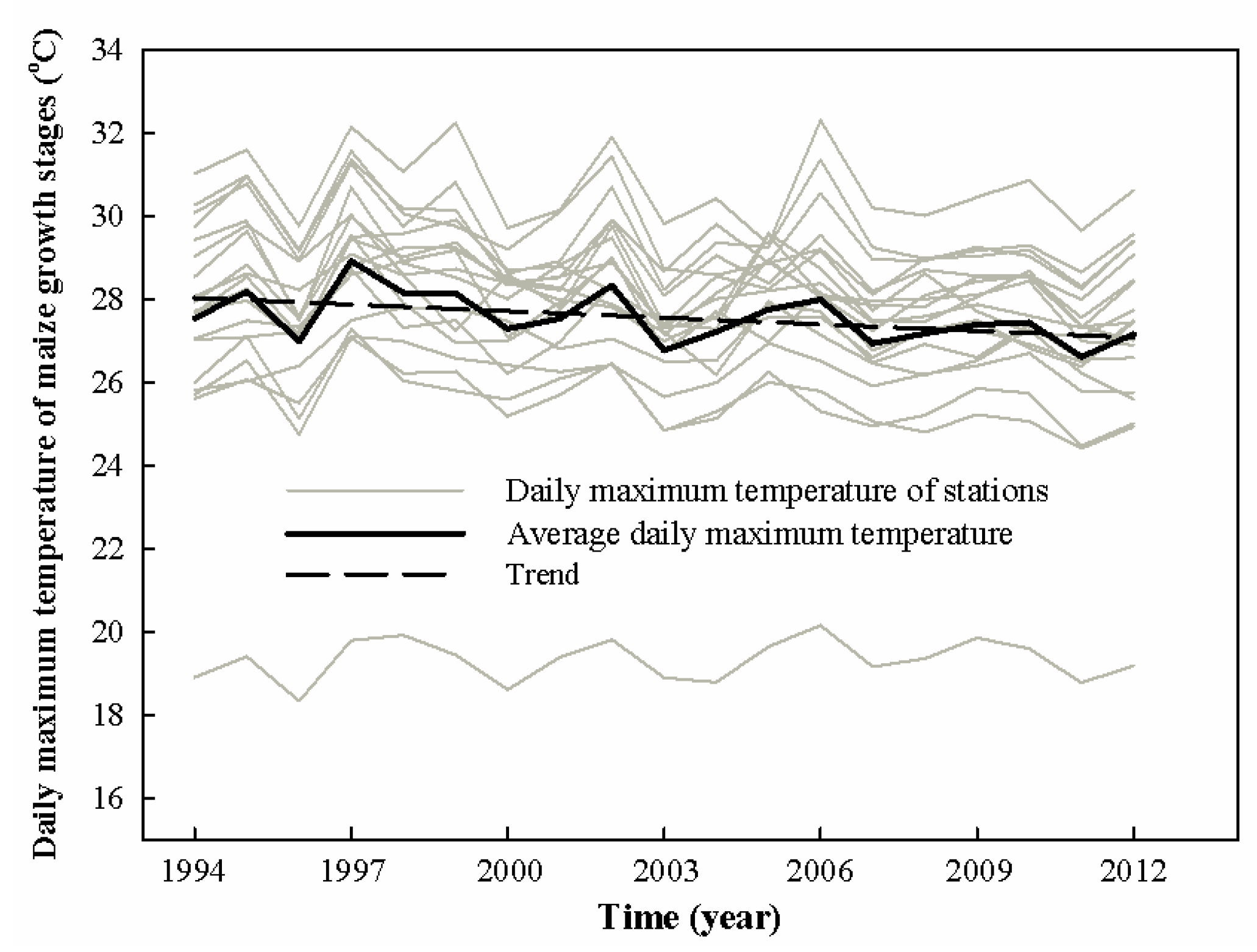
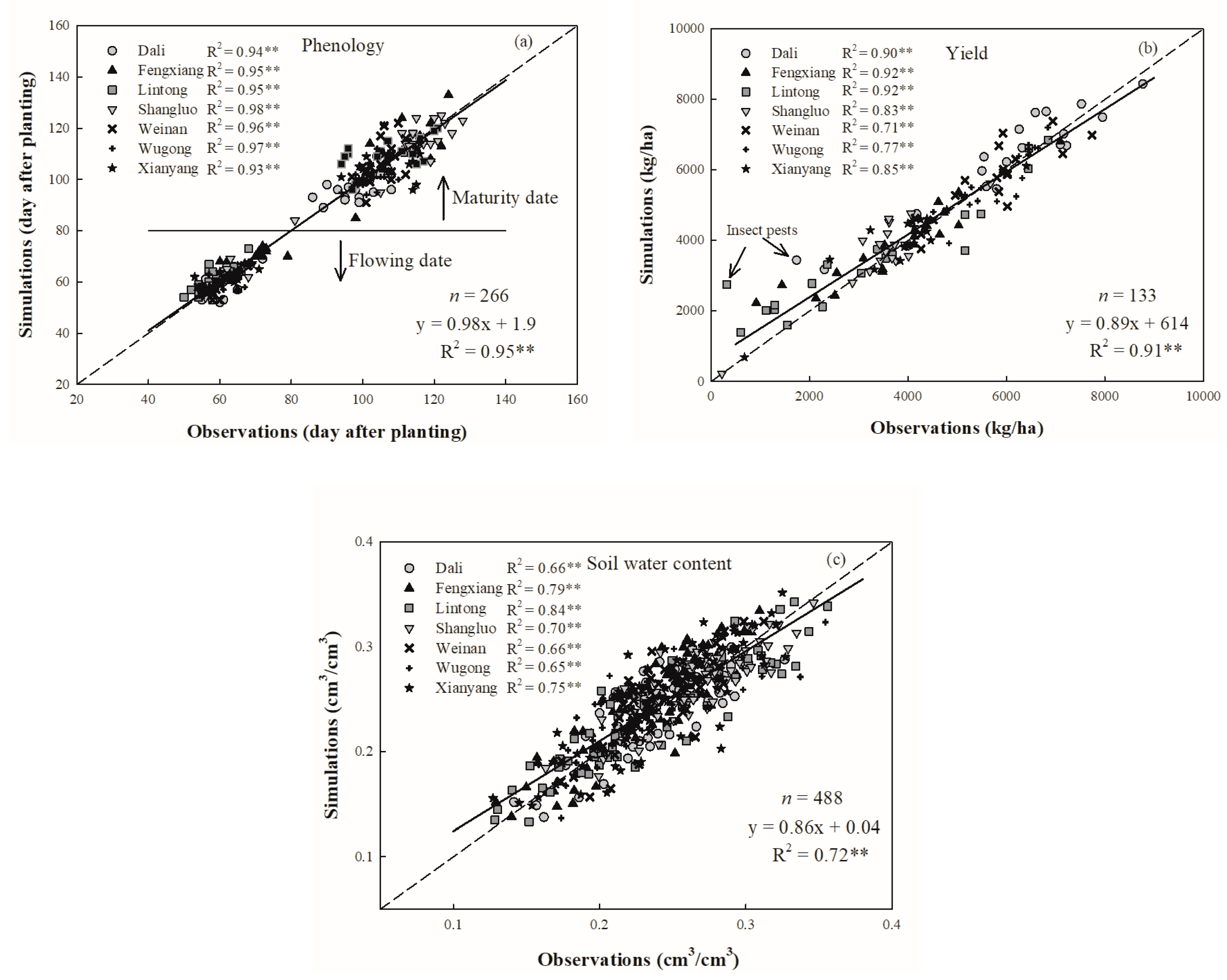
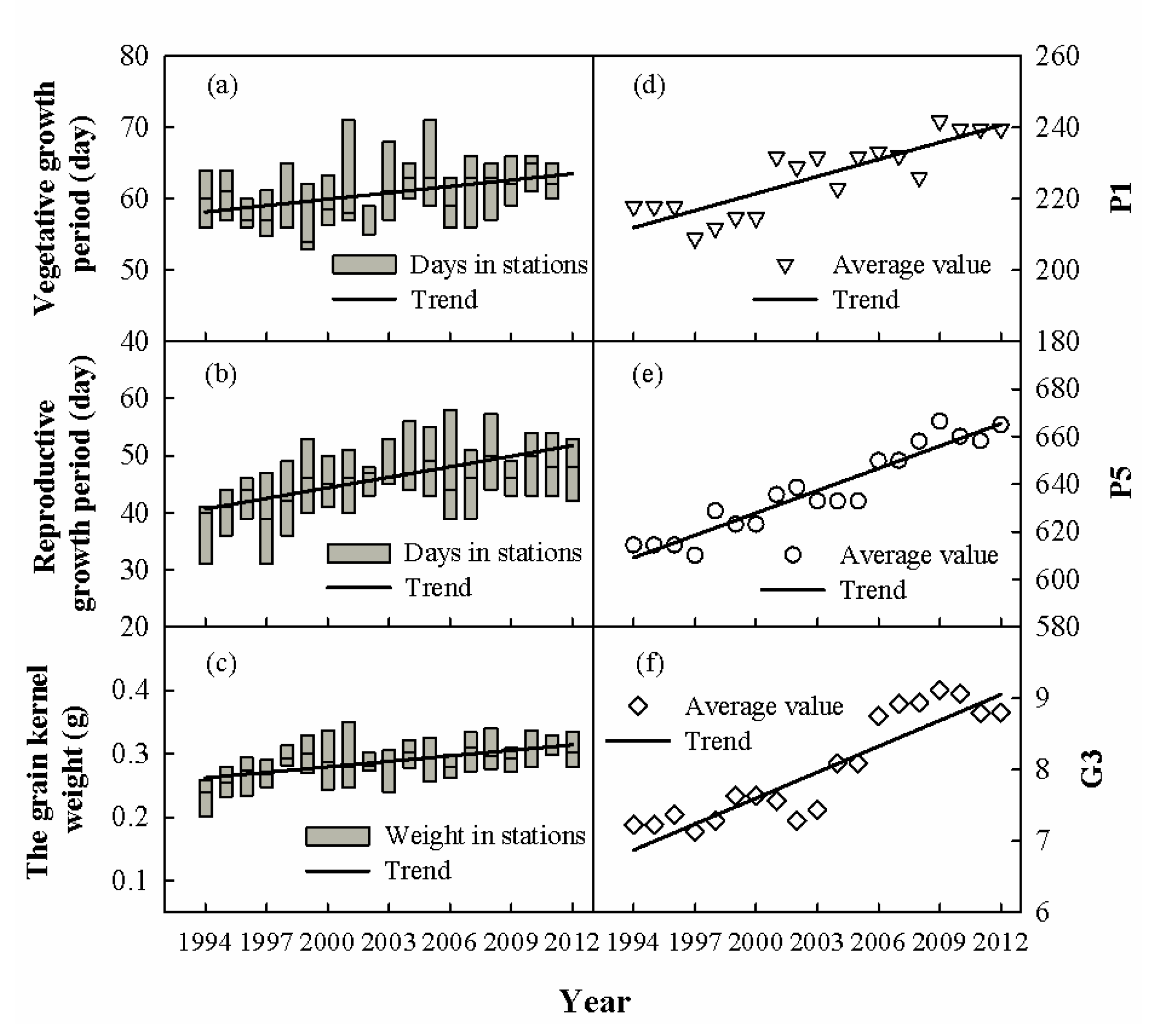
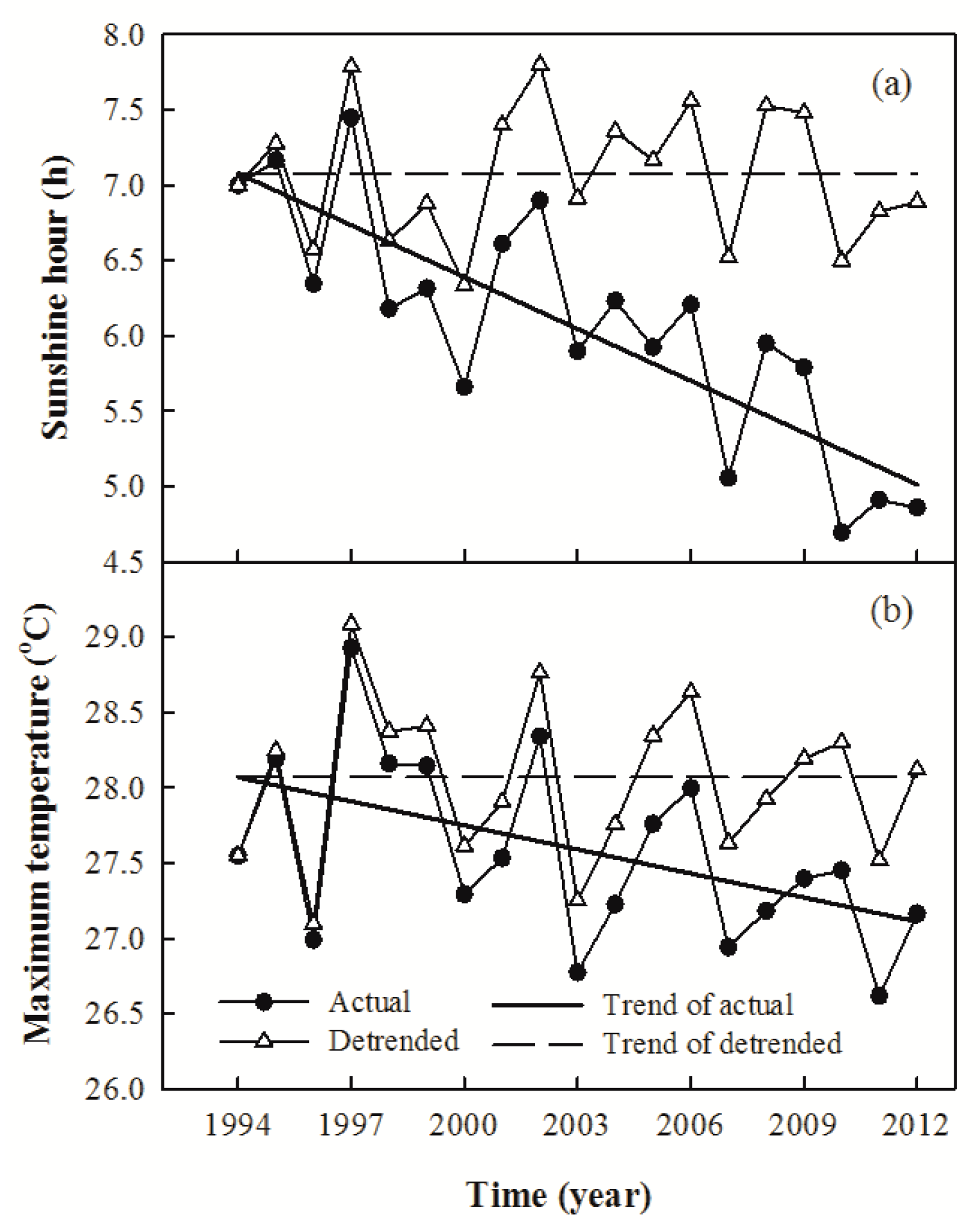


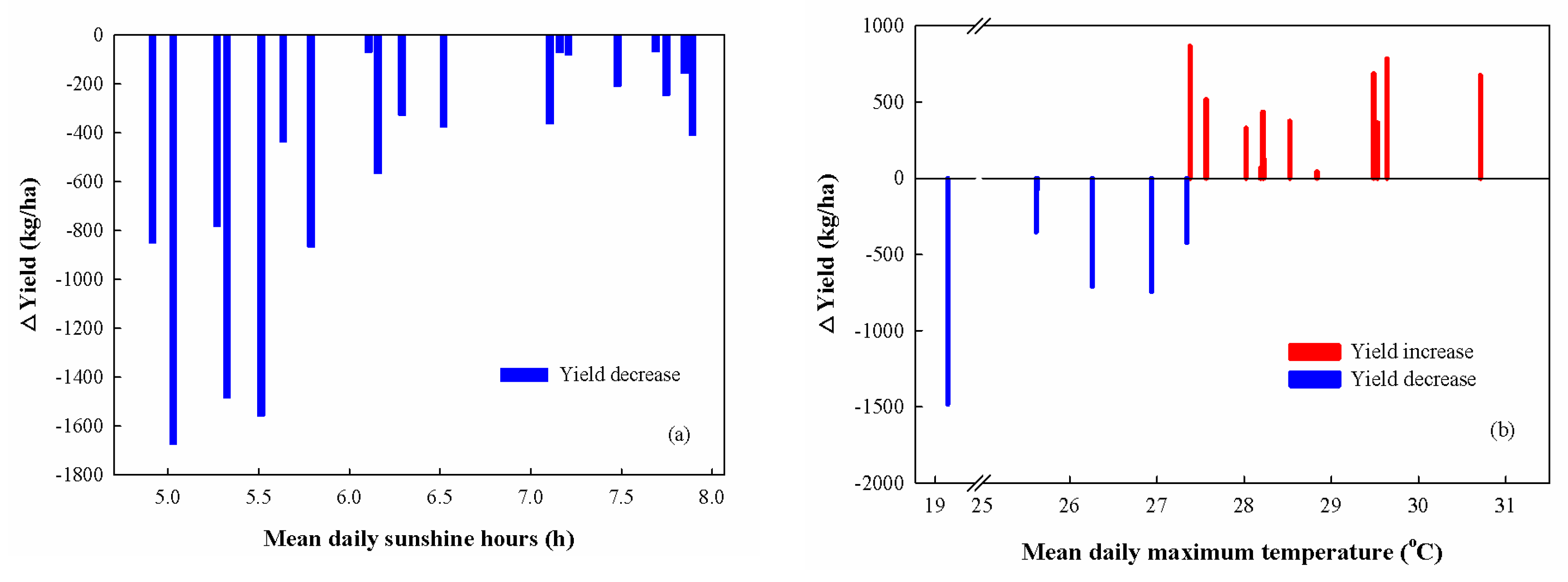
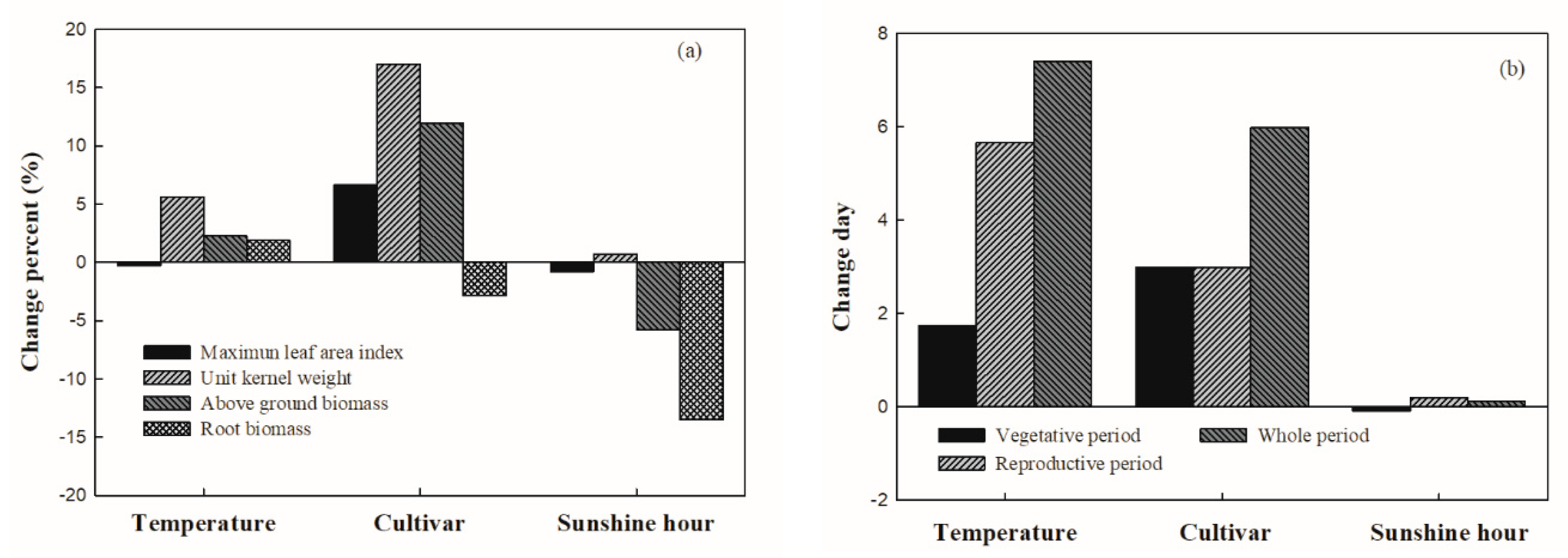
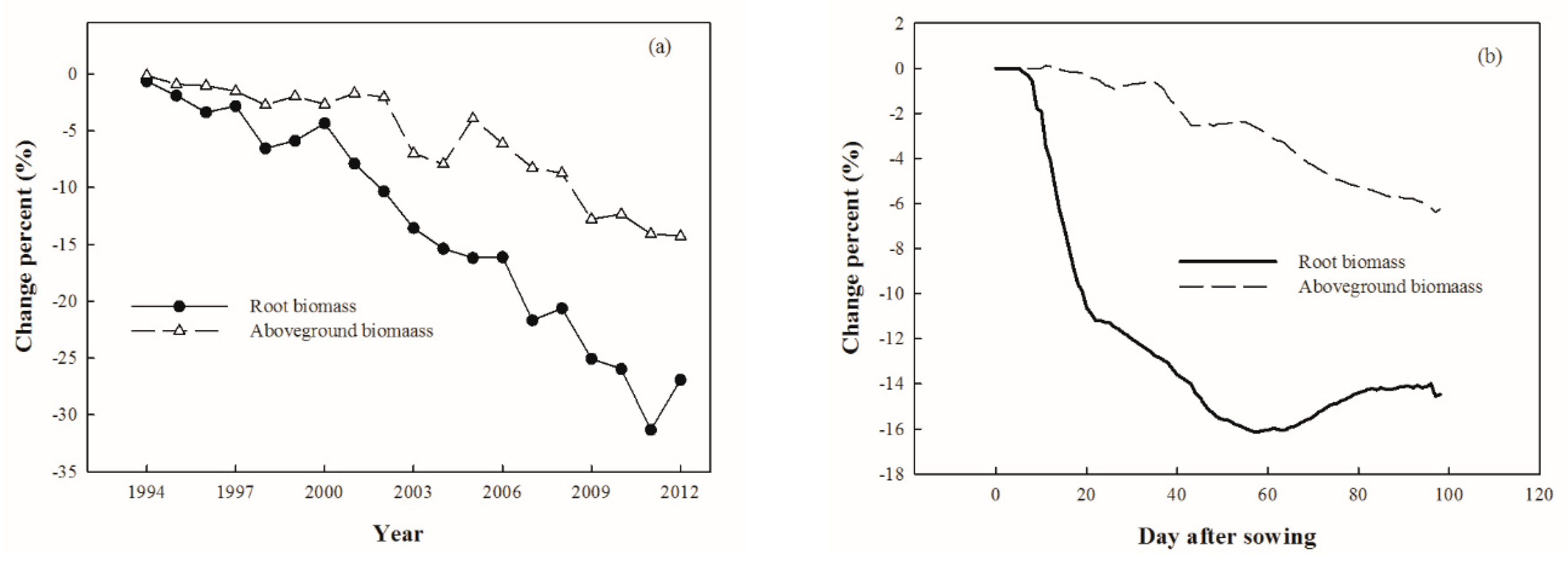
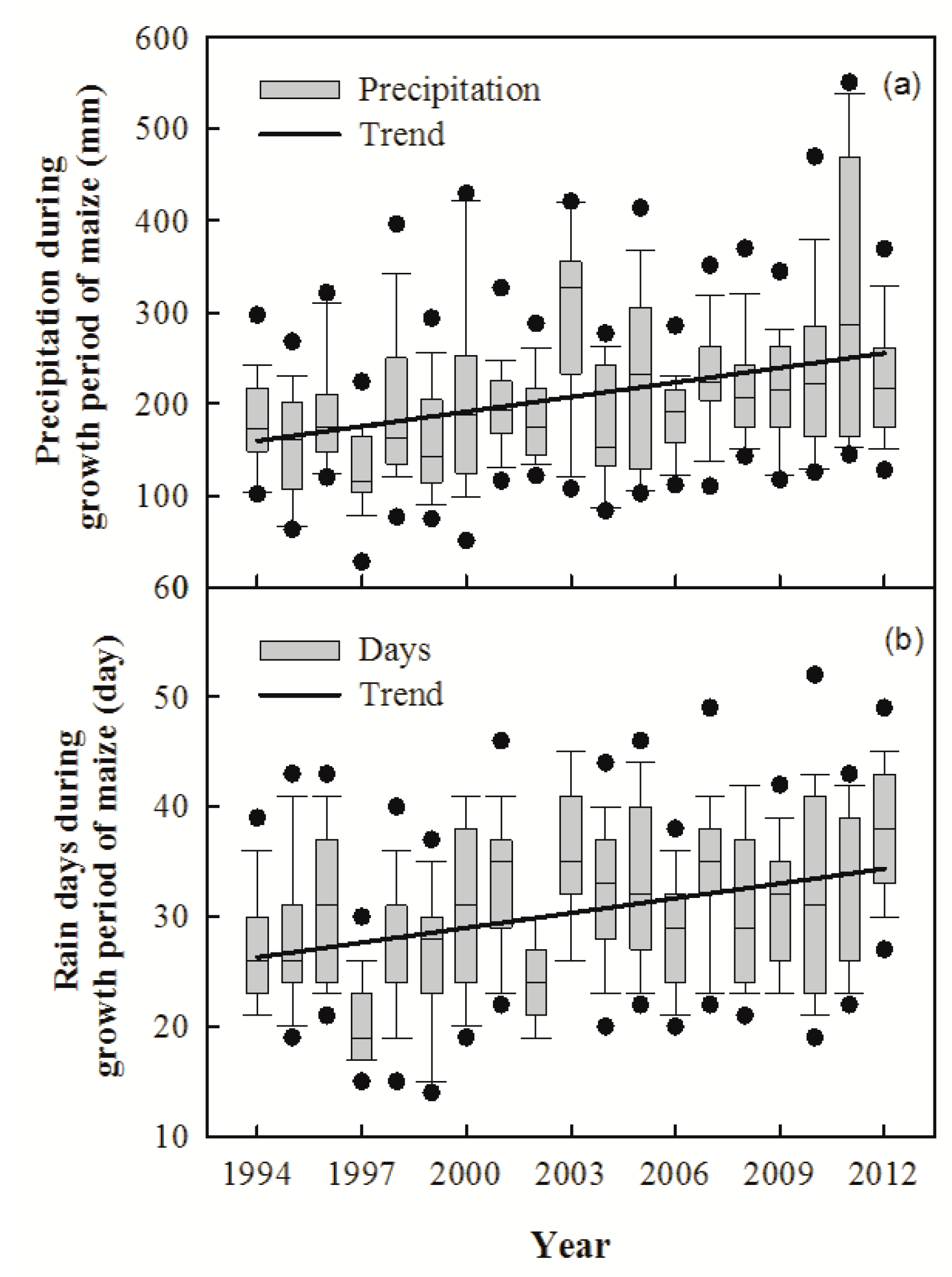
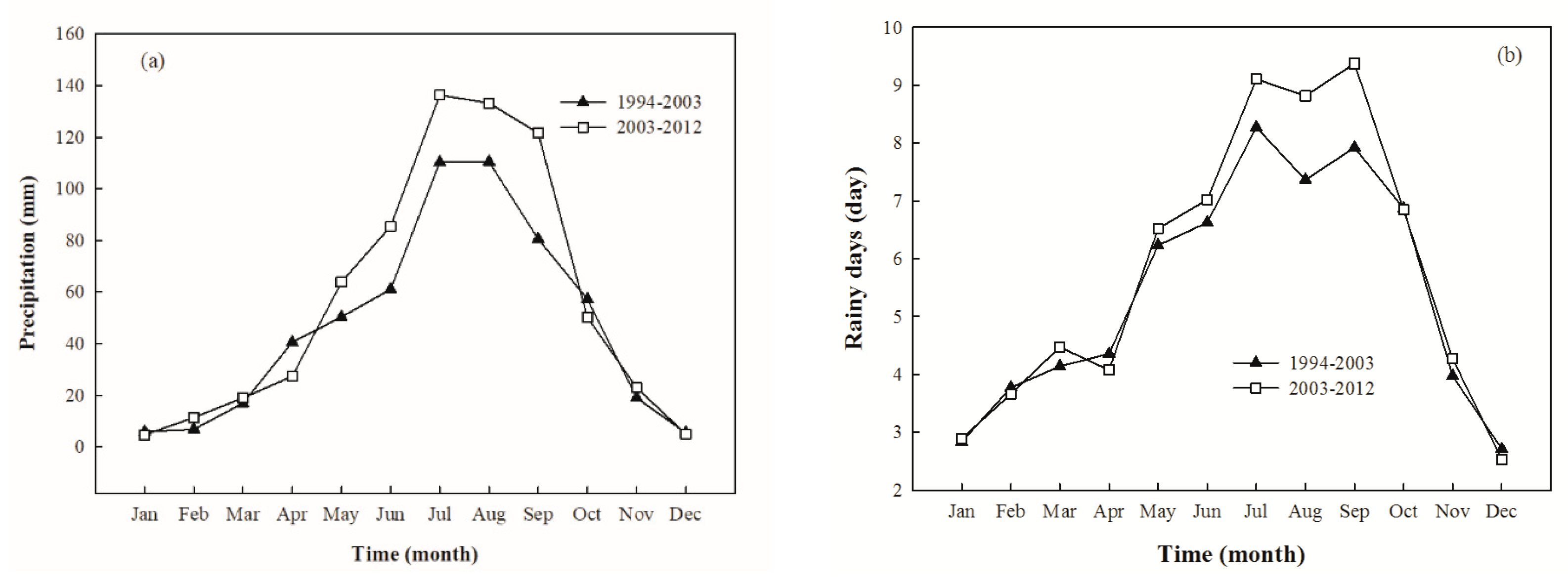
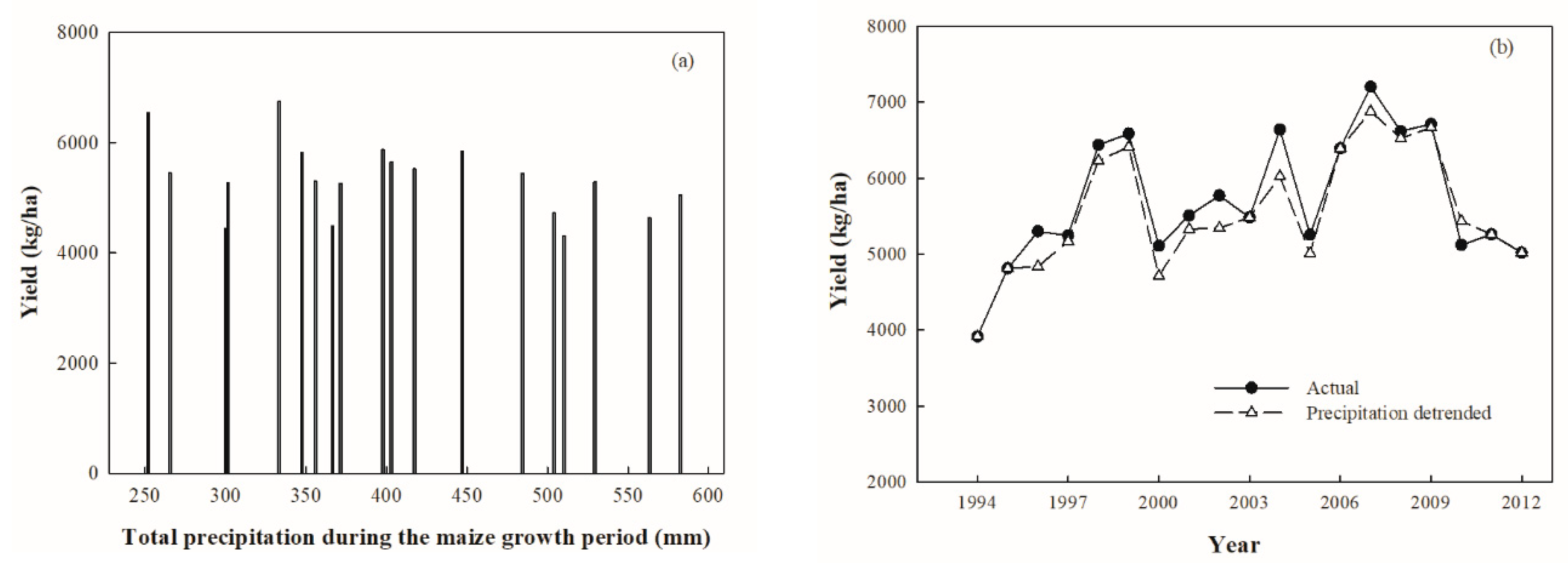
| Province | Total Number of Stations | Number of Stations with SSH Decrease |
|---|---|---|
| ShaanXi | 19 | 18 |
| ShanXi | 27 | 24 |
| ShanDong | 23 | 20 |
| HeNan | 19 | 16 |
| HeBei | 20 | 15 |
| NeiMengGu | 45 | 33 |
| LiaoNing | 33 | 23 |
| JiLin | 29 | 20 |
| HeiLongJiang | 31 | 20 |
| Parameter | Definition | Unit | Range |
|---|---|---|---|
| P1 | Thermal time from seedling emergence to the end of the juvenile phase | °C d | 100–400 |
| P2 | Photoperiod sensitivity coefficient | 0–4 | |
| P5 | Thermal time from silking to physiological maturity | °C d | 600–1000 |
| G2 | Maximum possible number of kernels per plant | 500–1000 | |
| G3 | Kernel filling rate during the linear grain-filling stage under optimum conditions | mg/d | 5–12 |
| PHINT | Interval in thermal time (degree days) between successive leaf tip appearances | °C d | 30–75 |
| Site | Cultivar Name | Calibration Data | Validation Data |
|---|---|---|---|
| DaLi | HuDan1 | 1994–1995 | 1996 |
| HuDan2 | 1998 | 1997 | |
| HuDan3 | 1999, 2000 | 2001 | |
| HuDan4 | 2002–2004 | 2005 | |
| JunDan | 2006, 2007 | 2008 | |
| JunDan20 | 2009–2011 | 2012 | |
| FengXiang | HuDan | 1994–1996 | 1997 |
| ShanDan | 1998, 1999 | 2000 | |
| DengHai1 | 2001–2004 | 2005 | |
| ZhengDan | 2006 | 2007 | |
| ZhengDan518 | 2008 | 2009 | |
| ShanYu782 | 2010–2011 | 2012 | |
| LinTong | HuDan | 1994, 1995 | 1996 |
| ZhangYu | 1997–1999 | 2000 | |
| GaoNong1 | 2001–2004 | 2005 | |
| HuDan4 | 2006–2011 | 2012 | |
| ShangLuo | HuDan | 1994–1999 | 2000 |
| ShenDan10 | 2001–2006 | 2007 | |
| DengHui11 | 2008 | 2009 | |
| ZhengDa12 | 2010, 2011 | 2012 | |
| WeiNan | DanYu13 | 1994–1999 | 2000 |
| HuDan4 | 2001–2004 | 2005 | |
| JiYu9 | 2006 | 2009 | |
| ZhengDan958 | 2007, 2008, 2010, 2011 | 2012 | |
| WuGong | ShanDan9 | 1994–1996 | 1997 |
| ShanDan902 | 1998, 1999 | 2000 | |
| YeDan19–1 | 2001, 2002 | 2003 | |
| ZhengDan958 | 2004–2007 | 2008 | |
| ZhongKe11 | 2009 | 2010 | |
| ZhangYu9 | 2011 | 2012 | |
| XianYang | XiDan2 | 1994, 1995 | 2002 |
| YeDan12 | 1996, 1997 | 1998 | |
| GaoNong2 | 1999, 2000 | 2006 | |
| Shan911 | 2001, 2003, 2004 | 2005 | |
| ZhengDan958 | 2007, 2010 | 2011 | |
| JunDan20 | 2008, 2009 | 2012 |
| Name | SSH | Temperature | Cultivar |
|---|---|---|---|
| Original | Actual | Actual | Actual |
| SSH | Detrended | Actual | Actual |
| Tmax | Actual | Detrended | Actual |
| Cultivar | Actual | Actual | Unchanged |
| Climate | Detrended | Detrended | Actual |
| DaLi | FengXiang | LinTong | ShangLuo | WeiNan | WuGong | XianYang | ||
|---|---|---|---|---|---|---|---|---|
| SSH | Average (hour) | 6.2 | 5.5 | 5.5 | 5.8 | 6.5 | 5.3 | 5.3 |
| Trend (hour/decade) | −1.2 ** | −1.0 ** | −1.0 ** | −0.9 ** | −1.3 * | −1.3 ** | −1.3 ** | |
| Tmax | Average (°C) | 28.3 | 27.6 | 27.4 | 28.2 | 28.5 | 29.5 | 29.5 |
| Trend (°C/decade) | −0.1 | −0.8 * | −0.8 * | −0.7 * | −0.8 | −1.1 * | −1.1 * | |
| Tmin | Average (°C) | 17.3 | 17.5 | 17.4 | 17.8 | 18.6 | 19.5 | 19.5 |
| Trend (°C/decade) | 0.0 | 0.4 | 0.3 | 0.0 | −0.2 | −0.4 | −0.4 | |
| Tave | Average (°C) | 22.2 | 22.1 | 22.1 | 22.2 | 23.1 | 24.0 | 24.0 |
| Trend (°C/decade) | 0.0 | −0.3 | −0.3 | −0.5 * | −0.6 * | −0.8 ** | −0.8 ** | |
| PRE | Average (mm) | 447 | 398 | 402 | 417 | 356 | 366 | 366 |
| Trend (mm/year) | 8.4 | 10.8 ** | 8.5 | 11.8 * | 7.7 | 17.0 ** | 17.0 ** |
| DaLi | FengXiang | LinTong | ShangLuo | WeiNan | WuGong | XianYang | ||
|---|---|---|---|---|---|---|---|---|
| Planting date | Average (Day of year) | 159 | 164 | 162 | 161 | 162 | 163 | 166 |
| Trend (days/decade) | −2.3 | 2.5 | −5.2 * | −2.4 | 0.7 | 0.3 | −2.7 | |
| Flowering date | Average (Day of year) | 220 | 232 | 220 | 222 | 219 | 222 | 227 |
| Trend (days/decade) | 0.5 | 5.6 ** | −2.9 | 3.3 | 1.4 | 5.1 ** | 1.3 | |
| Maturity date | Average (Day of year) | 259 | 275 | 269 | 276 | 263 | 268 | 271 |
| Trend (days/decade) | 4.3 | 9.8 ** | 6.7 | 12.5 ** | 5.6 * | 7.0 * | 5.2 | |
| Vegetative period | Average (days) | 61 | 67 | 59 | 61 | 57 | 59 | 62 |
| Trend (days/decade) | 2.8 | 3.4 * | 2.4 | 5.7 ** | 0.7 | 4.8 ** | 1.1 | |
| Reproductive period | Average (days) | 39 | 43 | 49 | 54 | 44 | 47 | 44 |
| Trend (days/decade) | 5.5 ** | 4.2 | 9.5 ** | 9.2 | 4.1 * | 1.6 | 3.9 * | |
| Entire growth period | Average (days) | 99 | 110 | 108 | 115 | 101 | 106 | 107 |
| Trend (days/decade) | 6.5 ** | 7.3 * | 11.9 ** | 14.9 ** | 4.8 ** | 6.7 ** | 4.9 * |
| Cultivar Name | Cultivar Coefficients | Calibration ARE (%) | Validation ARE (%) | |||||
|---|---|---|---|---|---|---|---|---|
| P1 | P2 | P5 | G2 | G3 | PHINT | |||
| HuDan1 | 260 | 0.157 | 669.9 | 874.8 | 7.951 | 69.12 | 13 | 4.6 |
| HuDan2 | 227.8 | 0.11 | 662.8 | 813.8 | 7.09 | 65.06 | 2.6 | 37.8 |
| HuDan3 | 227.8 | 0.11 | 662.8 | 813.8 | 9.79 | 65.06 | 7.3 | 14.2 |
| HuDan4 | 227.8 | 0.11 | 662.8 | 813.8 | 9.79 | 65.06 | 11.1 | 5.8 |
| JunDan | 262.8 | 0.835 | 706.6 | 802.6 | 10.44 | 68.18 | 5.6 | 3.8 |
| JunDan20 | 353.2 | 0.157 | 765.1 | 874.8 | 11.65 | 69.12 | 8.4 | 5.9 |
| HuDan | 180 | 0.557 | 479.9 | 874.8 | 7.951 | 69.12 | 8.8 | 6 |
| ShanDan | 227.8 | 0.11 | 470.9 | 813.8 | 7.09 | 65.06 | 8.7 | 20.7 |
| DengHai1 | 262.8 | 0.51 | 470.9 | 700.8 | 6.09 | 65.06 | 9.1 | 3.5 |
| ZhengDan | 227.8 | 0.51 | 460.8 | 873.8 | 7.951 | 65.06 | 10.2 | 0.5 |
| ZhengDan518 | 222.8 | 0.51 | 470.8 | 813.8 | 7.951 | 65.06 | 10.4 | 9.8 |
| ShanYu782 | 227.8 | 0.11 | 512.8 | 873.8 | 7.09 | 65.06 | 7.4 | 8.4 |
| ZhangYu | 150 | 0.11 | 456.8 | 813.8 | 7.09 | 65.06 | 6.9 | 2.3 |
| GaoNong1 | 180 | 0.11 | 556.8 | 813.8 | 7.09 | 65.06 | 3.3 | 6.2 |
| ShenDan10 | 227.8 | 0.11 | 662.8 | 713.8 | 6.09 | 65.06 | 8.9 | 17 |
| DengHui11 | 200.8 | 0.11 | 662.8 | 813.8 | 6.2 | 65.06 | 4.1 | 3.9 |
| ZhengDa12 | 200 | 0.157 | 622.9 | 813.8 | 6.7 | 65.06 | 8.8 | 2.3 |
| DanYu13 | 247.8 | 0.11 | 722.8 | 513.8 | 7.49 | 65.06 | 7.3 | 9.5 |
| JiYu9 | 247.8 | 0.11 | 770.9 | 813.8 | 9.79 | 65.06 | 7.9 | 1.8 |
| ZhengDan958 | 227.8 | 0.11 | 662.8 | 813.8 | 9.79 | 65.06 | 3.9 | 7.9 |
| ShanDan9 | 227.8 | 0.11 | 622.8 | 813.8 | 6.09 | 65.06 | 9.4 | 1.7 |
| ShanDan902 | 227.8 | 0.11 | 762.8 | 813.8 | 8.09 | 65.06 | 1.1 | 12 |
| YeDan19−1 | 227.8 | 0.11 | 662.8 | 813.8 | 6.09 | 65.06 | 6.4 | 0.1 |
| ZhongKe11 | 227.8 | 0.11 | 662.8 | 813.8 | 9.79 | 65.06 | 4.1 | 5.4 |
| ZhangYu9 | 227.8 | 0.157 | 649.9 | 874.8 | 7.951 | 69.12 | 3.2 | 4.5 |
| XiDan2 | 227.8 | 0.11 | 662.8 | 513.8 | 6.09 | 65.06 | 24.2 | 2.8 |
| YeDan12 | 227.8 | 0.11 | 662.8 | 813.8 | 7.09 | 65.06 | 2.1 | 4.6 |
| GaoNong2 | 247.8 | 0.51 | 622.8 | 813.8 | 6.79 | 65.06 | 5.9 | 32.7 |
| Shan911 | 247.8 | 0.11 | 622.8 | 813.8 | 7.99 | 65.06 | 8.2 | 4.1 |
| Average | 7.5 | 8.3 | ||||||
Publisher’s Note: MDPI stays neutral with regard to jurisdictional claims in published maps and institutional affiliations. |
© 2020 by the authors. Licensee MDPI, Basel, Switzerland. This article is an open access article distributed under the terms and conditions of the Creative Commons Attribution (CC BY) license (http://creativecommons.org/licenses/by/4.0/).
Share and Cite
Song, L.; Jin, J. Effects of Sunshine Hours and Daily Maximum Temperature Declines and Cultivar Replacements on Maize Growth and Yields. Agronomy 2020, 10, 1862. https://doi.org/10.3390/agronomy10121862
Song L, Jin J. Effects of Sunshine Hours and Daily Maximum Temperature Declines and Cultivar Replacements on Maize Growth and Yields. Agronomy. 2020; 10(12):1862. https://doi.org/10.3390/agronomy10121862
Chicago/Turabian StyleSong, Libing, and Jiming Jin. 2020. "Effects of Sunshine Hours and Daily Maximum Temperature Declines and Cultivar Replacements on Maize Growth and Yields" Agronomy 10, no. 12: 1862. https://doi.org/10.3390/agronomy10121862
APA StyleSong, L., & Jin, J. (2020). Effects of Sunshine Hours and Daily Maximum Temperature Declines and Cultivar Replacements on Maize Growth and Yields. Agronomy, 10(12), 1862. https://doi.org/10.3390/agronomy10121862





